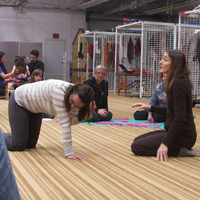Unbearable Attempts to Sit Still
I will always remember Jai.
When I met him, Jai was 5 years old and could not sit still. He could not stand still. He could not lie down and be still.
He could hardly stop talking.
Jai's mother brought him to me hoping that the neurodevelopmental movements I teach would help him. Her intuition told her it was not normal that Jai often hurt himself. Several times a day Jai would fall, crash into things, hit his head, then cry in pain and frustration.
In our first session, I asked Jai to lie down on his back so I could check for primitive reflexes on his feet. Primitive reflexes are important; they belong to a group of neurodevelopmental movements--the innate movements of infancy required for proper brain, body and sensory development.
Jai hesitated, then lay down on his back.
In a split second he was up again, motoring through the room. There was absolutely no time to check his feet.
Feels "like I'm gonna explode"
We played some and then I introduced an innate rhythmic movement that was enjoyable and calming. Innate rhythmic movements are another category of neurodevelopmental movement that also fuel brain and body growth. After a minute of gentle rhythmic rocking, Jai seemed slightly more settled. I thought, "Now is my chance to check those feet!"
So I asked Jai again if he would lie down.
Jai complied and lay down on his back. I looked at Jai's face and noticed his eyes opening wide, indicating a stress response.
So I asked him:
"What does it feel like when you lie on your back like this?"
Jai answered immediately: "Like I'm gonna explode".
Wow.
I reassured Jai that I would check his feet very quickly and then he could get up and play again.
Without even having to think about it, Jai could so clearly feel and express his discomfort. At such a young age he was aware of his body's intense internal chaos.
That was many years ago, but Jai's words still have meaning for me, because there are so many children like Jai.
How can they focus, listen and learn when they cannot be still even when they want to?
Is it any wonder they have meltdowns and behavior challenges?
Jai's story helps us understand how unreasonable it is to ask children to be still when they are physically incapable of doing this without great discomfort.
While it is true that very young children should not be expected to be still for long periods, it is also important that as they get older, children can be comfortable while being still in order to focus on meaningful activities and play.
For children like Jai, stillness is completely inaccessible and when attempted, unbearable.
These children need our help.
But first we must understand what the root of the problem is.
The Real Reason Many Children Cannot Be Still
During a training course with Harald Blomberg, MD* he explained that many children cannot sit still because of immaturity in the basal ganglia of the brain. The basal ganglia must be mature in order for us to comfortably be still. But maturity of the basal ganglia does not happen automatically as we get older. It only happens if the neurodevelopmental movements--primitive reflexes, innate rhythmic, and developmental movements--are not disrupted during womb-life and infancy.
The problem is that there are many factors in modern society that combined, prevent our children from receiving full measure of these special movements in infancy, the time when the basal ganglia should be maturing. Left with an immature brain and sensory system, it is impossible to sit still, challenging to focus, and learning and behavioral issues arise as a result.
The good news is that we can introduce these movements at any age and the brain will respond just as it does in infancy, with more connectivity, growth and maturity in the basal ganglia. In fact the whole brain, body and sensory systems mature from these unique movements.
Jai was sent home with a neurodevelopmental movement program that he did with his mom and dad on a regular basis. When I saw Jai 5 weeks later, he waked purposefully into the session room. He was proud of himself and much more settled. His mom said, "He is not hurting himself any more. He sleeps better, he is eating more, he can sit still and draw, and his drawings are much more complicated. He is much happier."
Jai still had work to do to fully integrate his brain and body. But he was on track and the neurodevelopmental movements continued to help him immensely.
Take Away Summary: The ability to be still requires sufficient brain maturity. Brain maturity requires repeated movement, specifically the powerful innate neurodevelopmental movements of infancy that the brain recognizes and requires to develop.
Neurodevelopmental movements provide a drug-free remedy for challenging behavior, poor focus, sensory processing issues, learning challenges and inability to be still.
Learn more about the supporting research
*Harald Blomberg, MD and Moira Dempsey developed Rhythmic Movement Training and are the co-authors of the book, Movements That Heal. See www.rhythmicmovement.org




